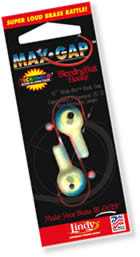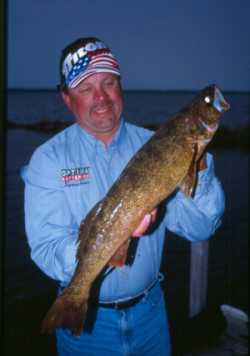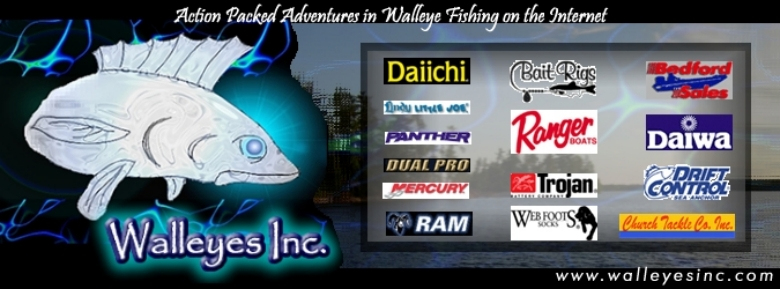|
Magic is in the air. Winter has disappeared.
Ice has turned to water. The days are getting longer. New
life is evident everywhere. For those of us who love to fish
for river walleyes, it's a time when we can escape like Houdini
from our daily routines for a few hours on the water. We can
turn a few months worth of dust into solid gold. We can make
walleyes seemingly appear from thin air. If our heads were
big enough, we might even be able to pull a walleye out of
our hats. Truth is, catching April walleyes or sauger isn't
all that tricky. It's one time of year when nature concentrates
these species in predictable locations as they prepare for
and then carry out their annual spawning ritual. These are
hungry fish. Their metabolism is increasing as the water temperatures
slowly climb. Instinctively, they eat more to build strength
in the weeks leading up to the rigors of procreation. And
with all those fish packed into relatively small areas, there
is plenty of competition for food. Exactly when the spawn
occurs depends on water temperature and the length of the
days, and it varies from one body of water to another. However,
all walleyes and sauger in a given system don't spawn at exactly
the same time. One river can produce pre-spawn and post-spawn
fish on the same day. With all of these factors at work, all
an angler needs to do is wave his or her magic wand, whether
it's a spinning rod, a trolling rod or a live-bait rod. One
of the unique aspects of fishing for walleyes at this time
of year is that no matter what your favorite presentation,
you can usually make it work. You can jig, rig, cast, drift,
troll or anchor. You can fish with hair jigs, plastics, live-bait
rigs or crankbaits. The magic touch Vertical jigging is probably
the most popular method for catching April walleyes. Done
properly, it allows the angler to keep his or her bait in
the strike zone without requiring much energy from those big,
lazy female walleyes to track it down and eat it. Prime locations
for vertical jigging are current breaks, eddies and the edges
of sand flats. In most river systems, there is abundant forage,
especially in the tailwaters below the dams where walleye
and sauger congregate in the spring. Because they are lazy
by nature, especially larger walleyes, they seek out slack-water
areas from which they can easily ambush prey with little physical
effort. While smaller males tend to roam the shallower sand
flats, it's been my experience that the most active larger
fish can usually be found near the upstream edge of a current
break or eddy where they get the first crack at any forage
that passes by. After an active feeding period, they likely
slide back into the middle of the eddy or find something to
rest behind along a current break (such as a rock, a sand
hump or a stump) where they can still be tempted to eat if
you make it easy enough for them. Eddies and current breaks
can usually be identified visually by watching the surface
of the water and the changes in current flow. Finding and
holding the edges of sand flats and other breaklines where
walleyes and sauger congregate require the use of a good sonar
unit like Lowrance's X111 HD. River systems hold many species
of fish and while the X111 HD can't tell me for certain what
species I'm watching below, the detail, definition and separation
a quality unit provide usually tell me what I want to know.
Don't overlook the shallow slack water, either. In some systems,
the best place to get out of the current is along the shoreline
where the high water that typically occurs in spring creates
all kinds of hiding places. I've pulled some of my largest
April walleyes from water less than six feet deep. The key
to vertical jigging is staying vertical. Current flow will
dictate how heavy and what style of jig to use. In general,
I use the smallest jigs that the situation allows. It's imperative
that you are able to maintain contact with the bottom and
feel everything going on at the end of your line. Once you
start a drift, stay on top of your jig. Many anglers believe
they're fishing vertically, but in fact are dragging their
jigs around and missing bites they never feel because of the
bow the current is creating in their line under the water's
surface. If your line is angled more than few degrees upstream,
you either need to go with a lighter jig or slow down your
drift until you can get over the top of your jig again. I
use my MinnKota Maxim bow-mount to slow down my Triton 215X.
If your line is angled more than 45 degrees downstream, you
need to try a heavier jig and/or speed up your drift. Sometimes,
all it takes is trimming up my Mercury outboard to pick up
the speed necessary to stay on top. Jig and plastic and/or
minnow combinations can target a walleye or sauger's senses
of sight, scent and sound.
 |
In moderate current, a quarter-ounce LindyMax
Gap Jig jig with the bleeding red hook in one of the
Techni-Glo colors is about as visible as a jig gets. Add
a Munchies Thumpin' Ringworm or Thumpin' Grub for vibration
and more visual appeal. Tip the rig with a minnow for
scent appeal. Especially strong current dictates changes
in size and head style. Switch to a more aqua-dynamic
jig head that cuts the current better like Lindy's Jumbo
Jig. Another way to make your jig more visible is to add
one of Headlight Lures' fiber-optic bodies. They attach
to the collar of the jig and have protruding extensions
that create the appearance of glowing eyes. By using natural
light for energy, they don't need batteries or recharging.
Disappearing act April river fishing attracts plenty of
anglers, and can create a lot of pressure and boat traffic
in small areas. Sometimes, it's better to pull out of
the pack, anchor up and let the fish come to you. As with
vertical jigging, the best place to start is on the upstream
edge of an eddy, washout or current break. |
One advantage of fishing in this manner is that
it allows an angler two presentations. You can dead-stick
a live-bait rig while casting a jig-plastic or jig-minnow
combination to seek out those active fish. Fan-cast as much
of the area as you can, then pull up anchor, relocate 20 or
30 yards downstream and work that area over. Wingdams offer
another anchoring option. The physics of moving water create
a dead spot along the face of the dam similar to an eddy,
and there are usually scattered rocks and boulders where fish
can wait in ambush, too. Another hotspot can be found on the
downstream side of a wingdam just inside the tip where a current
break is created as the water rushes past. Sleight of hand
While everyone else is doing the jigging thing, it's also
possible to catch April walleye and sauger trolling crankbaits.
Forget about the traditional belief that these fish can't
be caught on hard baits when water temperatures are less than
45 degrees.
 |
It's been proven many times over the past 10 years that
they will, indeed, respond to cranks. April isn't immune
to cold weather, and that's one advantage of cranking.
You can set your lines and go without reaching into a
minnow bucket or exposing your hands to the elements in
the interest of maximum "feel" when jigging. You can also
cover more water and sometimes find pods of fish away
from the crowd that you can go back and work even more
effectively with a jigging presentation. For me, April
trolling usually means lead-core line that keeps my baits
in the strike zone along breaklines and edges where the
bottom is irregular. Inside and outside river bends are
likely areas to target, as well. I identify the stretch
I want to troll by exploring it while watching my Lowrance.
Because the X19 is also a GPS unit, it allows me to plot
a trolling course that will keep my lures in productive
water. Another pattern that can pile up some fish is to
line up a series of wingdams and troll across the tips.
If the fish seem to be fairly active, one of my favorite
baits is a Storm Hot 'N Tot. If they seem a little fussy,
I turn to a Thunderstick Deep Jr. |
The new MinnowStick is another excellent option.
In states where the law allows two lures per line, I like
a three-way rig with a Lindy Jumbo Jig or Storm WildEye soft-bodied
bait as a dropper and a small Thunderstick as a trailer. Without
a doubt, April is a great time of year to be on the water.
It's a great time to test your equipment to make sure it's
ready for the heart of the open-water season. It's a great
time to show family and friends what walleye fishing is all
about. It's a great time to work your walleye magic.
|

